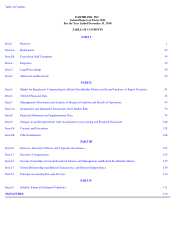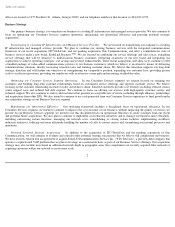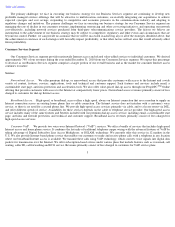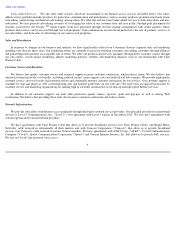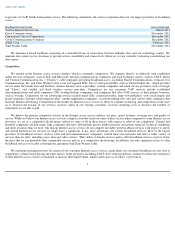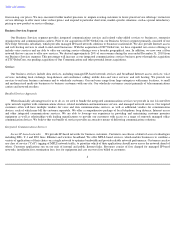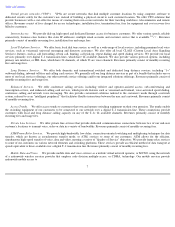Earthlink 2010 Annual Report Download - page 14
Download and view the complete annual report
Please find page 14 of the 2010 Earthlink annual report below. You can navigate through the pages in the report by either clicking on the pages listed below, or by using the keyword search tool below to find specific information within the annual report.
Table of Contents
leases or indefeasible rights-of-
use agreements. As of December 31, 2010, ITC^DeltaCom's network extended to over 200 points of presence.
These points of presence are located in most major population centers in the areas covered by the fiber optic network and in a significant number
of smaller towns and communities. The network included 44 completed metro fiber rings.
We have implemented electronic redundancy over a portion of our network, which enables traffic to be rerouted to another fiber in the same
fiber sheath in the event of a partial fiber cut or electronic failure. In addition, as of December 31, 2010, approximately 74% of ITC^DeltaCom's
network traffic was protected by geographical diverse routing, a network design also called a "self-
healing ring," which enables traffic to be
rerouted in the event of a total cable cut to an entirely different fiber optic cable.
Switching and Colocation Facilities.
With the acquisition of ITC^DeltaCom, we also obtained a number of switching facilities. The
network design, together with interconnection agreements with the incumbent local telephone companies, such as AT&T, enables us to be a
facilities-
based provider of local and long distance telephone services in all of our markets. Switches are the primary electronic components that
connect customers to our network and transmit data and voice communications over our network. As of December 31, 2010, our switching
facilities for voice communications consisted of eleven Nortel DMS-
500 switch sites, two Nortel Call Server 2000 IP switch sites and seven
Alcatel-Lucent 5E switch sites. All of the switches are capable of handling both data and local and long distance voice traffic.
We have colocated communications equipment within the central offices of incumbent local telephone companies in various markets in the
southern United States. Colocation enables us to provide remote facilities-
based local and long distance services in markets where we do not
have switches, by using our switches in other locations as hosts. To provide these remote services, we use our fiber optic network and leased
facilities to connect our remote equipment to our switches when it is economically and operationally advantageous for us to do so.
Our network backbone enables us to offer high-
quality wavelength, Ethernet, synchronous optical network, or SONET, Internet access and
virtual private networking services. The packet-
switching portion of our network backbone is based upon Internet Protocol, which is a broadly
deployed standards-
based protocol that allows for the exchange of data between computer networks. The network infrastructure is built on our
high speed Infinera-based wavelength division multiplexing, or WDM, platform and Cisco core routers.
Competition
Integrated Communications.
The communications industry is highly competitive, and we expect this competition to intensify. These
markets are rapidly changing due to industry consolidation, an evolving regulatory environment and the emergence of new technologies. We
compete directly or indirectly with ILECs, such as AT&T, Qwest, Windstream Corporation ("Windstream") and Verizon; other competitive
telecommunications companies, such as Covad, Level 3, PAETEC and XO Holdings; interexchange carriers, such as Global Crossing and Sprint
Nextel; wireless and satellite service providers; cable service providers, such as Charter Communications, Inc., Comcast, Cox
Communications, Inc. and Time Warner Cable; and stand-
alone VoIP providers. Competition could adversely impact us in several ways,
including (i) the loss of customers and resulting revenue, (ii) the possibility of customers reducing their usage of our services or shifting to less
profitable services, (iii) reduced traffic on our networks, (iv) our need to expend substantial time or money on new capital improvement projects,
(v) our need to lower prices or increase marketing expenses to remain competitive, and (vi) our inability to diversify by successfully offering
new products or services.
We believe the primary competitive factors in the communications industry include price, availability, reliability of service, network
security, variety of service offerings, quality of service and reputation of the service provider. While we believe our business services compete
favorably based on some of these factors, we are at a competitive disadvantage relative to some or all of these factors with respect to some of our
10


